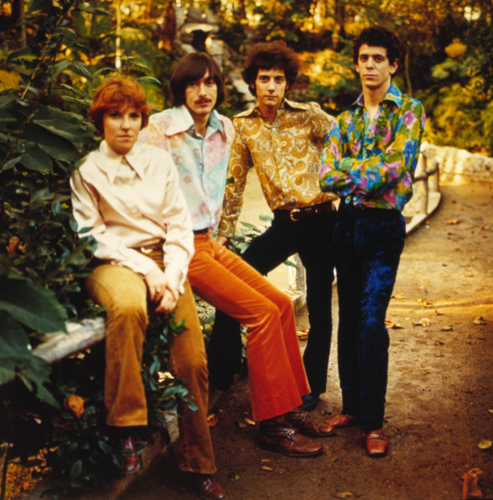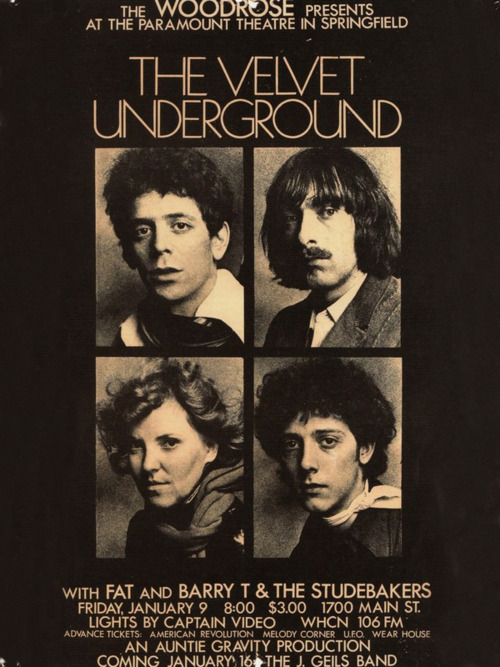
Here’s my latest review for the Collectors Music Reviews website and blog, of a new, unofficially released rare recording of the great Velvet Underground at their old Boston Tea Party stomping grounds, ringing out the old year of 1968 (a very hard year on a number of home fronts).
The Velvet Underground – The Boston Tea Party 1968 (The Godfatherecords 948/949)
Live at the Boston Tea Party, Boston, MA. December 12, 1968
CD1: (56:00 min.): Heroin, I’m Gonna Move Right In, Waiting For The Man, I’m Set Free, Foggy Notion, Beginning To See The Light, Candy Says, White Light White Heat, Jesus
CD2 (75:00 min.): Sister Ray, Pale Blue Eyes BONUS TRACKS: Hilltop Pop Festival, Rindge, New Hampshire, August 2, 1969 Waiting For The Man, Run Run Run, Pale Blue Eyes, What Goes On, Heroin

Who said paisley can’t be badass? As close to ‘flower power’ as the Velvets ever got, 1968-69. L–R: Maureen Tucker, Sterling Morrison, Doug Yule, Lou Reed.
One night sometime back in 1969, the Velvet Underground were taking a break between sets at a club somewhere in Middle America. They had just finished songwriter Lou Reed’s nightmare paean to addiction, “Heroin,” when an irate club owner angrily approached Reed and the rest of the band.
“If you play that drug song again, you’re fired!” the incensed owner told Reed. The band returned to the stage for its second set and, of course, immediately played “Heroin” for the second time. And got fired. “If the legacy of the Velvet Underground was about anything, it was about claiming the right to say what you feel,” remembered Velvets bassist-guitarist Doug Yule in an interview I conducted with both he and drummer Maureen Tucker back when a deluxe two-disc CD edition of the band’s 1970 swan song album, “Loaded,” was about to be released by Rhino Records. “In the 1950’s and early 60’s, there were certain parameters to rock and roll,” Yule recalled. “But by the late 1960’s, we were starting to push the boundaries of what you were allowed to sing and what you were allowed to think.”
The Velvet Underground were, first and foremost, always about pushing boundaries — of what was considered acceptable subject matter; of conventional pop song structures; and, finally, of what rock music could — and should — be. Uncompromising, unflinching, and undimmed by the passage of time, the Velvets remain one of the most significant rock n’ roll bands in history, arguably as essential to rock’s core vocabulary as Chuck Berry, the Beatles, Rolling Stones, or Bob Dylan.
The stark lyrical realism of Reed’s urban portraits, coupled with the Velvets’ remarkable facility for dramatic musical extremes, culminated in some of rock’s unequivocal masterpieces: “Waiting For The Man”; “Pale Blue Eyes;” and of course “Sweet Jane,” which features perhaps the most copied guitar chord progression of all-time. The band’s influence and aesthetic can be found in much of the “alternative” music that would come after, genetically programmed into bands like Sonic Youth, the Jesus & Mary Chain, Spacemen 3, Galaxie 500 (and its Dean Wareham-led offshoot, Luna), Mazzy Star, and Yo La Tengo. The list goes on and on from there.

So says Lester “Banks”! Ad copy error, or did Lester’s legendary nemesis/antagonist helpfully provide this novel spelling of Bangs’s name to the record company for publication? Only Lou and Les knew for sure.
By the end of 1968, co-leader/viola player John Cale had departed the Velvets after one too many power struggles with Reed, and in his place stood the considerably mellower Yule, who also happened to play bass, organ, and sing (not unlike Lou, it turned out; he takes a good chunk of the vocal duties on “Loaded,” as a disenchanted Reed was already halfway out the door and thinking about his imminent solo career).
This is the lineup that hit the Boston Tea Party for a multi-night stand in the winter of 1968 — a series of concerts that have, at one time or another, surfaced on unofficial audience recordings over the years, and for good reason. For one thing, the Velvets had visited the venue regularly and felt comfortable playing there; so much so that, despite being based in New York City, they were considered an unofficial Boston Tea Party “house” band. Secondly, by the time December ’68 rolled around, this slightly softer (and possibly more accessible) incarnation of the Velvets was, indeed, much closer in feel to their namesake than the coarsely confrontational and decidedly more avant-garde Cale version that had released the blistering “White Light/White Heat” LP earlier the same year. With Yule, the Velvets had recorded, and were soon to release, their pastoral, even folk-tinged self-titled third album, “The Velvet Underground,” (a back-to-basics title choice that reflected a reintroduction and re-boot of sorts, perhaps?).

The only time they smiled: Not exactly what the Velvets were about, eh? Art taken from an old tour poster/program, presumably
Nearly half of the group’s set list during this period in general – and the Dec. 12, 1968 Boston Tea Party date in particular – was comprised of numbers from the forthcoming new album. Songs such as the narcotic gospel soul that beats at the heart of “I’m Set Free,” for instance, and the confessional story of love and infidelity, “Pale Blue Eyes,” reflect this new direction.
It comes as no surprise that the Godfatherecords label, which has over the past several years become a (pardon the pun) underground industry standard for excellence, does a typically terrific job with its first foray into Velvets territory. The straightforwardly titled “The Boston Tea Party 1968” is as bluntly direct and unvarnished as the band and its music itself, even if the lovely packaging is not. Presented in a sumptuous tri-fold cardboard sleeve replete with a handful of mostly period-accurate black and white photographs, the pictures and stark beauty of the package both capture the essence of the Velvets’ coolly monochromatic aesthetic. The music does the rest.
Sourced, presumably, from very good-to-excellent quality audience tapes of both the Dec. 12 show, as well as a handful of bonus tracks on disc two culled from the “Hilltop Pop Festival” in New Hampshire the following summer (August 2, 1969), the two discs do a good job of translating the sonic yin-yang approach favored by a band that was as musically fluid as it was insistent. This was a unit capable of blunt, brute force and a fabulously fuzzed-out attack, leavened with contemplative chord progressions and pretty pop melodies (a product, no doubt, of Reed’s early music gig as staff songwriter for Pickwick Records).
The audio quality of these mono tapes overall, to these ears at least, is on a punchy par with most of what’s been released before – some of it even official, such as “Live At Max’s Kansas City,” “1969,” and “Bootleg Series Vol. 1: The Quine Tapes” (the latter recorded by Velvets fanatic and future Richard Hell & the Voidoids guitar wizard Robert Quine, who would also eventually go on to play and tour with Reed). The bottom line: If you’re a Velvets fan who’s familiar with those aforementioned titles, you’ll be neither disappointed nor surprised by the sound here, and will likely be happy to have such a uniformly strong performance in hand culled from one of the band’s best periods.
Perhaps as a litmus test of sorts to get any potential trouble from the club owner or promoter out of the way early (or ensure an abruptly abbreviated set), Reed and Co. kick off the show with — yep — a bold, bracing reading of “Heroin,” with Lou in sturdy voice and drummer Maureen Tucker in even sturdier primal beat form. Carried along by guitarist Sterling Morrison’s bewitching lyricism set against Reed’s gruffer guitar tones, the song builds and builds into a swirling head rush of crashing, chaotic majesty. It’s a manic sonic monument of pure noise as blissful nirvana that seems to perfectly emulate the effect of what happens when – yes, not if but inevitably when – the singer stabs that spike into his waiting vein. “It’s my wife, and it’s my life,” Reed declares as a matter-of-fact explanation of its power and his hopeless devotion to its hold.
At the outset of “Waiting For The Man,” Reed, in a seemingly good mood, chats amiably with the audience, telling them that the band now plays the number quite a bit slower than they used to. And it is true that the selection is somewhat slowed down (even from the following summer’s jaunty “Hilltop Pop” version that appears on disc two). Here, the band trades the tune’s jonesing-for-a-fix urgency for a relaxed, hanging-on-the-street corner vibe. But it’s still no ballad.
What is a ballad, and a gently gorgeous one at that, is the semi-autobiographical chronicle of “Candy Says,” a tender homage to Andy Warhol protégé and transgender Factory Superstar Candy Darling (who reappears as the “Candy” in Reed’s “Walk On The Wild Side,” and who would later die of lymphoma at the age of 29 in 1974). “White Light White Heat” brings things back to a blistering, sustained boil before simmering down again for the comedown plea of “Jesus.”
The five live “bonus tracks” that round out the bulk of disc two are a pleasure to listen to and feature Reed’s clear vocals more front-and-center in the mix. A 10-plus minute reading of the chugging, careening “Run Run Run,” from the band’s 1967 debut album, and the organ-saturated, nearly 12-minute jam, “What Goes On” (the band’s pick as a single off its third album, although you’d never know it here) dominate the second disc. They’re also the only two of the five tracks not included in the Boston Tea Party set. Both are given the kind of epically repetitive, droning performance that always defined a good part of the Velvets’ sound, vision, and outlook. In contrast, a wistfully autumnal “Pale Blue Eyes” offers a lovely contrast.
Disc two closes as disc one opened, with the band rushing on its collective run on “Heroin,” with the same kind of ferocious and dedicated devotion to match its audience. Well, everybody in the room, that is, except for an irate club owner or two.




I’m not proud of myself for this; but I once drunkenly told John Cale to “go fuck himself” behind the Crest Theatre in Sacramento, Ca.
No regrets.
LikeLike